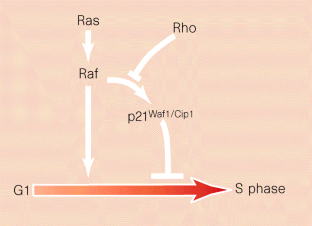Why Ras needs Rho (original) (raw)
- News & Views
- Published: 16 July 1998
Signal transduction
Nature volume 394, pages 220–221 (1998)Cite this article
- 201 Accesses
- 15 Citations
- Metrics details
Members of the Rho family of GTPase proteins regulate an assortment of processes: they rearrange the cytoskeleton; they activate lipid kinases, protein kinases and phospholipase D; and they can regulate transcription (reviewed in ref. 1). They are also essential for transformation of cells to an oncogenic state by another GTPase, Ras2, although it is not known which of Rho's many functions Ras actually needs. On page 295 of this issue, however, Olson, Paterson and Marshall3 describe a new effect of Rho, which explains how Rho helps Ras to transform cells.
Rho proteins are best known for their ability to bundle actin into stress fibres, and promote the assembly of focal adhesions where these fibres connect with cell-surface integrins. But these are clearly not the contribution that Rho makes to oncogenic transformation — cells transformed by Ras usually lack both stress fibres and focal adhesions1,4. In these cells, Rho must be doing something else. Olson et al.3 now show that Rho suppresses p21Waf1/Cip1, a well-known inhibitor of the cell cycle, thus allowing Ras to drive cells into S phase. What's more, they show that this is the only function of Rho that really matters in the context of Ras-induced DNA synthesis.
This is a preview of subscription content, access via your institution
Access options
Subscribe to this journal
Receive 51 print issues and online access
$199.00 per year
only $3.90 per issue
Buy this article
- Purchase on SpringerLink
- Instant access to full article PDF
Prices may be subject to local taxes which are calculated during checkout
Additional access options:
Figure 1: Regulation of Ras-dependent DNA synthesis by Rho.

References
- Van Aelst, L. & D'souza-Schorey, C. Genes Dev. 11 , 2295–2322 (1997).
Google Scholar - Qiu, R. G., Chen, J., McCormick, F. & Symons, M. Proc. Natl Acad. Sci. USA 92, 11781–11785 (1995).
Google Scholar - Olson, M. F., Paterson, H. F. & Marshall, C. J. Nature 394, 295– 299 (1998).
Article ADS CAS Google Scholar - Hughes, P. E. et al. Cell 88, 521–530 (1997).
Google Scholar - Ridley, A. & Hall, A. Cell 70, 389 –399 (1995).
Google Scholar - Hill, C. S., Wynne, J. & Treisman, R. Cell 81, 1159– 1170 (1995).
Google Scholar - Woods, D. et al. Mol. Cell. Biol. 17, 5598–5611 (1997).
Google Scholar - Khwaja, A. et al. EMBO J. 16, 2783–2793 ( 1997).
Google Scholar - Sahai, E., Alberts, A. S. & Treisman, R. EMBO J. 17, 1350– 1361 (1998).
Google Scholar
Author information
Authors and Affiliations
- the Cancer Center, University of California at San Francisco, 2340 Sutter Street, San Francisco, 94115, California, USA
Frank McCormick
Rights and permissions
About this article
Cite this article
McCormick, F. Why Ras needs Rho.Nature 394, 220–221 (1998). https://doi.org/10.1038/28268
- Issue Date: 16 July 1998
- DOI: https://doi.org/10.1038/28268
This article is cited by
Rho GTPases in human carcinogenesis: a tale of excess
- Salvador Aznar Benitah
- Carolina Espina
- Juan Carlos Lacal
Revista de Oncología (2003)